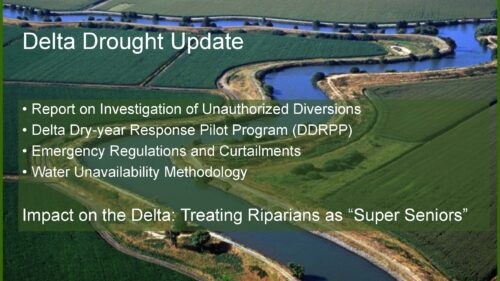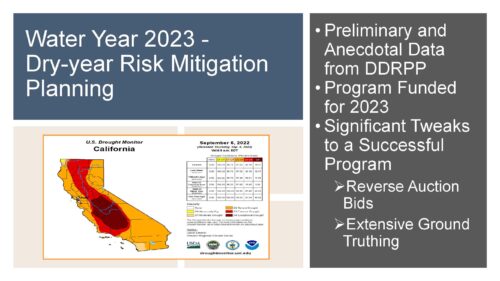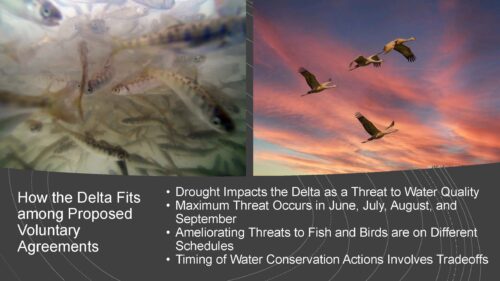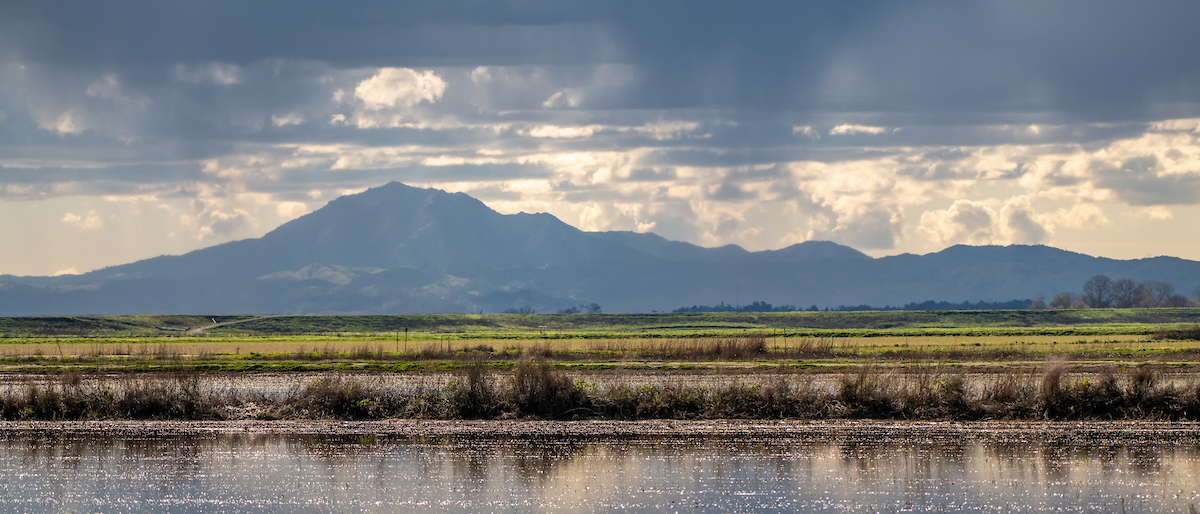At the September meeting of the Delta Stewardship Council, Delta Watermaster Michael George’s update included the completion of an investigation into unauthorized diversions in the Delta, the Delta Dry Year Response Program, and how projects underway in the Delta might fit into the implementation of the Water Quality Control plan, either through voluntary agreements or through regulatory requirements to implement the plan.
Mr. George began by noting that there is a focus on watershed protection, and what happens in the watershed ends up dramatically impacting the Delta. New technologies can provide new insights and new information. Those new technologies include Open ET, a satellite-based mechanism for accurately estimating the consumptive use of water by crops in the Delta; the proposal in the Governor’s water supply strategy to add 400 stream gauges and to repair another 200 that haven’t been maintained; and the effort at the State Water Board to develop a new electronic water rights information management system. However, the state remains challenged by drought.
Complaint of unauthorized Delta diversion coming to a close
 n 2021, the Board received a complaint from a group of export contractors that a portion of the water flowing through the Delta intended for the water projects was illegally diverted within the Delta. The matter was referred to the Office of the Delta Watermaster. A joint investigation with the Division of Water Rights and the complainants then proceeded.
n 2021, the Board received a complaint from a group of export contractors that a portion of the water flowing through the Delta intended for the water projects was illegally diverted within the Delta. The matter was referred to the Office of the Delta Watermaster. A joint investigation with the Division of Water Rights and the complainants then proceeded.
The complainants essentially used a mass balance analysis to determine the illegal diversions. Essentially, the complainants looked at how much water was released from storage, how much was exported from the South Delta, and how much was flowing out to the ocean, so the complainants reasoned that the rest of it was disappearing in the Delta through unauthorized depletions.
The investigation was unable to identify an actionable, unlawful diversion in the Delta. Mr. George said there are many reasons for that. One is that the roughly 300,000 acres in the North Delta have a contract with the State Water Project, so when there isn’t water for a water right in the North Delta, the water right falls back to the State Water Project contract. And because of the coordinated operations agreement, it affects both projects.
So the focus then turned to the remaining areas in the Central and South Delta and the portions of Eastern Contra Costa County, where the rights are mostly riparian and therefore limited to use on the riparian property.
Mr. George explained the complexity of water rights in the Delta. Riparians share shortage correlatively, which varies from the priority system for appropriators. In times of shortage, appropriators are cut off based on seniority or, ‘first in time, first in right.’ Riparians on a watercourse are supposed to share the shortage; however, there really isn’t a way to determine the correlative shortage for riparians. In the Delta, riparians and appropriators are in close proximity and often share the same watercourse, so determining who should cut back and by how much is very difficult, if not impossible: The riparians say that the correlative cutback can’t be determined until the appropriators are cut back to their appropriate priority, and the appropriators say that they can’t be cut off until the riparians reduce their demand on a correlative basis.
The report is being circulated for comments and should be available by the end of the month. The report will summarize the findings, document the methods used, and suggest possible ways of dealing with the unresolved issues from the investigation.
Executive Officer Jessica Pearson asked if there’s hope for resolving these issues in the future.
Mr. George said that some of the new technologies coming online will help. However, the Delta is complex. Our laws and concepts are more riverine: upstream, downstream, who has priority, and who needs to be curtailed for water to flow to the rightful user. The Delta does have riverine influences from the Sacramento River, the San Joaquin River, the Mokelumne River, the Calaveras River, Putah Creek, and other smaller creeks and rivers. There are many, and they are all highly variable; some are managed, some unmanaged, some managed high in the system, and others managed lower in the system.
However, the Delta is tidal, so tides are moving in and out twice a day; the tidal influence can be as much as 300,000 CFS in and out. That’s not necessarily new water coming in and other water flowing out, said Mr. George; it’s largely the same water sloshing in and out and mixing a little bit. So the riverine influence is critical in maintaining X2 in preventing salinity intrusion.
“So all those things are at play, and it’s very complicated,” said Mr. George. “Anything we would do, we’ll get sued for. Litigation on everything. There’s too much at stake, too much uncertainty, and too many alternative arguments to be made.”
Delta Dry-year Response Pilot Program (DDRPP)
 Last year, in response to dry conditions, the Delta Dry Year Response Pilot Program was created to understand what practices for agricultural water use and management in the Delta could reduce in-Delta consumption and help create a wider buffer against salinity intrusion. Due to low inflows to the Delta from the rivers, there was a real risk of losing salinity control in the Delta. Even with the barrier in place as West False River, salinity was starting to push up towards the main stem of the San Joaquin River.
Last year, in response to dry conditions, the Delta Dry Year Response Pilot Program was created to understand what practices for agricultural water use and management in the Delta could reduce in-Delta consumption and help create a wider buffer against salinity intrusion. Due to low inflows to the Delta from the rivers, there was a real risk of losing salinity control in the Delta. Even with the barrier in place as West False River, salinity was starting to push up towards the main stem of the San Joaquin River.
“If we had lost control of salinity in the Delta, it would have had an enormous impact because the amount of freshwater it would take to flush that out was off the charts, and it was water that we didn’t have,” said Mr. George. “So the risk that we faced helped to motivate a whole large number of agencies, California Department of Food and Agriculture, Department of Fish and Wildlife, Department of Water Resources, State Water Board, the Delta Watermaster, the three Delta water agencies, the Delta Conservancy, and some NGOs, as well as several farmers.”
“We created, on the fly, a grant program where we said, farmers tell us what actions, what tweaks to the management of your farms, do you think could have the most impact in terms of conserving water, and tell us what you’d be willing to do for a grant of $900 an acre. So we fixed the price; obviously, it would be too high for some and too low for others. But it was a price out there. And we said to farmers, shoot at this price tag; what do you think would make the most sense to accomplish those dual objectives of conserving water and dedicating that water to a broader buffer against salinity? Because we face drought risk in the Delta, not as lack of water, not as lack of physical supply, but as the risk of salinity intrusion that would reduce and potentially destroy the quality of that freshwater.”
The program received 88 proposals, 34 of which were funded, covering 9000 acres in the Delta. They monitored the fields with Open ET, Eddy covariance instruments, and satellite data.
“We have a treasure trove of data from both the participants and the monitoring mechanisms,” said Mr. George. “There was much learning between the regulators, project operators, and farmers. The farmers had credible hunches about what would work. Of course, they weren’t able to give exact estimates. But they knew what would work. And we’ve been able to create the data from these other data sources.”
The data is still being analyzed; the final report will be ready, possibly by November or December.
Anticipating the dry conditions to persist, the program has been funded for 2023. It will be a grant program again, although Mr. George said it would be a reverse auction this year. So instead of setting a price and asking farmers what they can do for that price, farmers will propose an action and the amount of funding to do it and then bid for it. Similar actions will be grouped together, and a market-clearing price will be determined. They will then look at the different actions and determine how much of each action to fund and where; those who bid and get selected will get paid the market clearing price. Mr. George acknowledged it’s complicated, so they are doing a lot of outreach to farmers.
“I’m hoping we’re going to get more actions, maybe smaller actions, which are tweaks on existing farming practices,” he said. “For instance, if you’re going to flood up for a duck club, maybe you can extend the period of time that you’re flooded up, perhaps a start earlier and finish later, that has positive impacts for migrating birds. And it shifts the water demand to a winter period instead of the summer period where there is a higher risk of salinity intrusion. So one of the requirements for proposing a project is that on a full water year basis, there has to be the expectation of net savings that are confirmed by Open ET investigation … so it could also have the effect of increasing water your water use in certain periods of the year to capture savings at a more critical time. And all of this will be confirmed based on Open ET.”
Curtailments
This year, the state board used its authority to implement emergency regulations to manage the curtailment process throughout the Delta watershed. Significant improvements were made to the water unavailability methodology used to determine how much water is available at what times. Updates were given weekly on which specific water rights were curtailed and, importantly, when they would come off of curtailment.
“That methodology has proven to be extremely valuable,” said Mr. George, noting that they were able to adjust the curtailments during the recent rains. “However, the impact on the Delta was very limited. Because of this incompatibility between how you manage shortage among riparians versus appropriators, what we really do in the methodology is treat the riparian as a super-senior. Therefore, the riparians never get curtailed and never experience that correlative reduction in their right to use until all the appropriators have been cut off. In other words, we stack the riparians in behind, on top, or underneath, depending on how you look at the appropriators.”
“In fact, during the most recent water year, in the North Delta, there were no curtailments because of the backup contract, although one of the things we’re working on is how do we account for when demand in the North Delta toggles from the underlying water rights to the water rights of the State Water Project? So it’s a complicated issue that we are only now getting into. This is the first time we’ve had this issue since that contract was entered into in 1981.”
“These are the issues that, now that we’re kind of out of the maximum risk period of the summer irrigation season, we’re looking at focusing on how we’re going to manage in the next year.”
Voluntary agreements and the Delta
 The larger context is how these changing practices in the Delta might fit into the proposed voluntary agreements or regulatory approaches to implementing water quality control planning.
The larger context is how these changing practices in the Delta might fit into the proposed voluntary agreements or regulatory approaches to implementing water quality control planning.
Mr. George reminded that the Delta experiences drought, not as a lack of water, but as a risk to water quality, so the maximum threat to water quality is in June, July, August, and September, which are the heavy irrigation months when flows from the rivers through the Delta is constrained. And yet, the threats to migrating fish tend to happen in the wintertime.
“So we’re looking now, with many partners, about what kinds of trade-offs make the most sense because we are focused on trade-offs,” said Mr. George. “It’s not like you can have everything you want. If you devote water or resources to one use, it affects other competing uses. And so we’re trying to figure out what we do in the Delta and what can be predictably done, either in a persistence of the current drought or when this next occurs.”
“So that’s one of the areas we’re focused on,” he continued. “We want predictable responses. But in those predictable responses, we want to take into account the inherent uncertainty in the system, which is changing rapidly. As we start any water year, there is uncertainty about what the hydrology will bring us, and how this should fit into an overall watershed-wide water quality control planning effort.”
Recruiting the next Delta Watermaster
Lastly, Mr. George said that recruiting is underway for his successor, as he will retire at the end of his term. Applications are being accepted through the end of October, with the hope of the new Delta Watermaster starting in January 2023.



